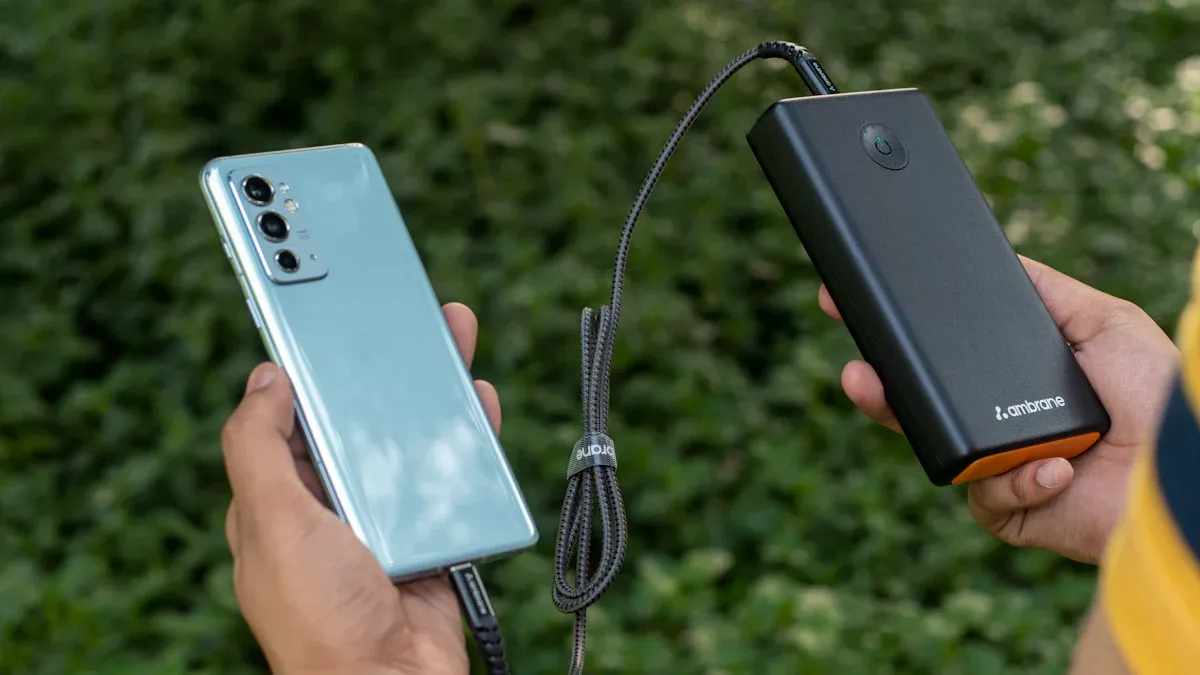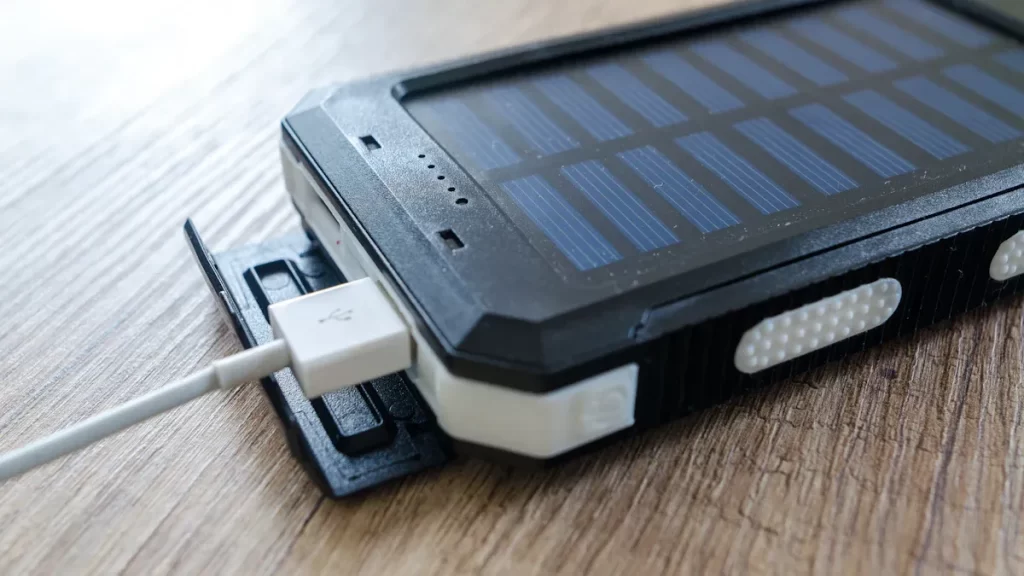Using a solar charger for mobile devices provides clean energy. It helps save money and protects the Earth. The initial cost might seem high, but you save in the long run. These solar chargers for mobile devices are environmentally friendly and keep you connected. Solar-powered devices are a smart choice for eco-conscious living.
Key Takeaways
Solar chargers turn sunlight into clean energy, helping the planet.
Buying a solar charger saves money by cutting electricity costs.
Portable solar chargers are light and simple to carry anywhere.
How Solar Chargers Work

The Basics of Solar Energy Conversion
Solar chargers use sunlight to make electricity. They have solar panels with photovoltaic (PV) cells. These cells, usually made of silicon, take in sunlight. The sunlight creates energy by moving electrons, forming an electric current. This process is called the photovoltaic effect. It is how solar chargers work. Some solar panels, like monocrystalline ones, are very efficient. They can convert up to 23% of sunlight into electricity. Special technology, like MPPT, helps improve power output. This ensures good charging even when sunlight changes.
Components of a Solar Mobile Charger
A solar charger has important parts to work properly. The solar panel collects sunlight and turns it into electricity. A converter makes sure the power is safe for your devices. Many chargers also have a battery to store energy. This lets you charge devices when there is no sunlight. Some chargers have extra features like USB ports or LED lights. Foldable designs make them easy to carry around.
Charging Your Devices with Solar Power
Using solar power to charge devices is easy. Put the charger in sunlight to collect energy. The charger turns sunlight into electricity for your device or its battery. Even without direct sunlight, solar chargers can still work. For example, a charger with two 7-volt panels can charge a phone in about three hours. Solar charging is a green and dependable way to stay connected.
Key Benefits of Solar Chargers
Eco-friendliness: Helping the Environment
Using a solar charger lowers your carbon footprint. These chargers use sunlight, not fossil fuels, for energy. This change cuts down harmful gas emissions. By picking solar-powered devices, you help make the planet cleaner.
🌱 Did you know? Solar chargers reduce carbon emissions and provide green energy for your devices.
Solar chargers replace the need for regular electricity.
They use renewable energy, which is better for the Earth.
Portable solar panels create eco-friendly power wherever you are.
Cost-effectiveness: Saving Money in the Long Run
Solar chargers might cost more at first, but they save money later. After buying one, you won’t need to pay for electricity to charge your devices.
Financial Factor | Regular Charging | Solar Charging |
|---|---|---|
Starting Costs | Lower | Higher (but tax credits help) |
Monthly Energy Bills | Ongoing/Changing | Much Lower or None |
Smaller | Bigger due to solar benefits |
Government programs, like a 30% tax credit, lower solar costs. Over time, the savings from solar chargers make them a smart and eco-friendly choice.
Portability: Easy Power Anywhere
Portable solar panels are great for outdoor trips. They are light and foldable, so you can carry them while camping or hiking. New solar chargers have advanced tech, like MPPT, for faster charging.
Feature | Details |
|---|---|
Efficiency | New panels convert 22-25% of sunlight into power. |
Size | Small designs make them easy to carry outdoors. |
Weight | Lightweight models are perfect for travel and adventures. |
Design | Foldable panels with handles are simple to use. |
Charging Technology | Smart features ensure steady charging in different conditions. |
With portable solar chargers, you’ll always have power wherever you go.
Reliability: A Handy Backup in Emergencies
Solar chargers are reliable during power outages. They don’t depend on the grid, keeping your devices charged in emergencies. Many solar chargers have big batteries, USB ports, and LED lights, making them useful in tough times.
Portable solar chargers are small and easy to store.
They provide green energy, supporting eco-friendly living.
High-capacity chargers can power several devices during blackouts.
Better solar technology has made these chargers more effective and cheaper. They are a dependable choice for emergency power needs.
Practical Uses of Solar Chargers
Outdoor Fun: Camping, Hiking, and Traveling
Portable solar panels are great for outdoor adventures. They give steady power when camping, hiking, or traveling far from cities. These panels are light and simple to carry, perfect for trips. New solar tech has made them work better and cost less. This makes them popular with outdoor fans needing power for devices.
In North America, more people are buying portable solar chargers. This is because outdoor activities are becoming more popular. Many like charging phones, cameras, or GPS devices without regular electricity. With these panels, you can stay connected and take photos while enjoying nature.
Emergency Use: Power During Blackouts
Solar chargers are very helpful during power outages. They keep your devices charged when electricity is unavailable. Many have built-in batteries to save energy for later. Tests show they work well even in bad weather, with up to 90% efficiency.
In emergencies, portable solar panels are a reliable backup. They can charge many devices and even run small appliances. Lab tests prove they store lots of energy, making them great for emergencies.
Off-Grid Living: Power for Remote Places
Solar chargers are important for living off the grid. They cut down on fossil fuel use and offer clean energy. Portable solar panels are handy in places without regular electricity. They provide endless renewable power, perfect for long-term needs.
Many people save money by switching to solar energy. Solar chargers also help the planet by lowering harmful gas emissions. Whether living off-grid or exploring remote areas, solar chargers give eco-friendly power.
Choosing the Right Solar Charger
Things to Think About: Size, Power, and Compatibility
Picking a solar charger means checking some important details.
Efficiency: Good panels, like monocrystalline ones, turn sunlight into power fast. They can convert up to 23% of sunlight into energy.
Capacity: This shows how much power the charger can hold. Higher capacity is better for charging more devices or bigger batteries.
Technology: MPPT features help chargers work well even with changing sunlight.
Portability: Lightweight and foldable chargers are easy to carry outdoors.
Durability: Strong materials protect chargers from weather and outdoor damage.
Customer Support: A 12-24 month warranty and good service are helpful.
🛠️ Tip: Make sure the charger’s voltage and plugs fit your device.
Types of Solar Chargers: Foldable, Portable, and Stationary
Solar chargers come in different styles for different needs.
Foldable Solar Chargers: These are small and easy to pack. They are great for hiking or camping trips.
Portable Solar Panels: These are handy for charging phones, tablets, and small gadgets.
Stationary Solar Chargers: These are bigger and stay in one place. They are good for off-grid homes or charging many devices.
Each type has its own benefits. Foldable and portable chargers are easy to move. Stationary chargers are better for long-term use and more power.
Tips to Keep Your Charger Working Well
Follow these tips to make your solar charger last longer:
Clean the panels to remove dust and dirt for better sunlight use.
Place the charger in direct sunlight for the best results.
Use MPPT chargers for faster and steady charging.
Store the charger in a cool, dry spot when not using it.
Don’t overcharge your devices to keep them and the charger safe.
🌞 Note: Monocrystalline solar chargers work well even in dim light.
By doing these things, your solar charger will stay strong and work well for years.
Solar chargers give a green way to power devices. They use sunlight, not fossil fuels, to make energy. This helps lower harmful gas emissions and protects the planet. Using these chargers fights climate change and saves money. Picking solar chargers supports a cleaner and healthier Earth.
🌍 Fact: Portable solar chargers turn sunlight into clean energy, reducing carbon footprints.
FAQ
What devices can solar chargers power?
Solar chargers can power phones, tablets, and cameras. They also work for small gadgets, laptops, and power banks.
Can solar chargers work on cloudy days?
Yes, they can work when it’s cloudy. But they make less power than on sunny days. Monocrystalline panels are better in low light.
How long does it take to charge a phone?
The time depends on sunlight and charger size. Usually, it takes 2-4 hours in bright sunlight.
🌞 Tip: Place the charger in direct sunlight for quicker charging.





